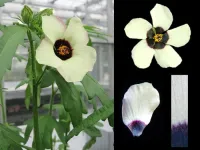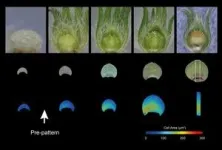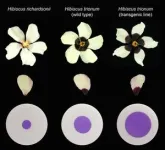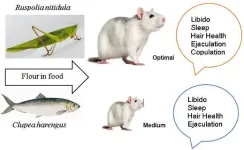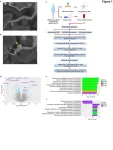(Press-News.org) Flowers like hibiscus use an invisible blueprint established very early in petal formation that dictates the size of their bullseyes – a crucial pre-pattern that can significantly impact their ability to attract pollinating bees.
The study, by researchers at the University of Cambridge’s Sainsbury Laboratory also found that bees prefer larger bullseyes over smaller ones and fly 25% faster between artificial flower discs with larger bullseyes – potentially boosting efficiency for both bees and blossoms.
Patterns on the flowers of plants guide insects, like bees, to the centre of the flower, where nectar and pollen await, enhancing the plant's chances of successful pollination. Despite their importance, surprisingly little is known about how these petal patterns form and how they have evolved into the vast diversity we see today, including spots, stripes, veins, and bullseyes.
Using a small hibiscus plant as a model, researchers compared closely related plants with the same flower size but three differently sized bullseye patterns featuring a dark purple centre surrounded by white – H. richardsonii (small bullseye covering 4% of the flower disc), H. trionum (medium bullseye covering 16%) and a transgenic line (mutation) of H. trionum (large bullseye covering 36%).
They found that a pre-pattern is set up on the petal surface very early in the flower’s formation long before the petal shows any visible colour. The petal acts like a 'paint-by-numbers' canvas, where different regions are predetermined to develop specific colours and textures long before they start looking different from one another.
The research also shows plants can precisely control and modify the shape and size of these patterns using multiple mechanisms, with possible implications for plant evolution. By fine-tuning these designs, plants may gain a competitive advantage in the contest to attract pollinators or maybe start attracting different species of insects.
These findings are published in Science Advances.
Dr Edwige Moyroud, who leads a research team studying the mechanisms underlying pattern formation in petals, explained: “If a trait can be produced by different methods, it gives evolution more options to modify it and create diversity, similar to an artist with a large palette or a builder with an extensive set of tools. By studying how bullseye patterns change, what we are really trying to understand is how nature generates biodiversity.”
Lead author Dr Lucie Riglet investigated the mechanism behind hibiscus petal patterning by analysing petal development in the three hibiscus flowers that had the same total size but different bullseye patterns.
She found that the pre-pattern begins as a small, crescent-shaped region long before the bullseye is visible on tiny petals less than 0.2mm in size.
Dr Riglet said: “At the earliest stage we could dissect, the petals have around 700 cells and are still greenish in colour, with no visible purple pigment and no difference in cell shape or size. When the petal further develops to 4000 cells, it still does not have any visible pigment, but we identified a specific region where the cells were larger than their surrounding neighbours. This is the pre-pattern.”
These cells are important because they mark the position of the bullseye boundary, the line on the petal where the colour changes from purple to white – without a boundary there is no bullseye!
A computational model developed by Dr Argyris Zardilis provided further insights, and combining both computational models and experimental results, the researchers showed that hibiscus can vary bullseye dimensions very early during the pre-patterning phase or modulate growth in either region of the bullseye, by adjusting cell expansion or division, later in development.
Dr Riglet then compared the relative success of the bullseye patterns in attracting pollinators using artificial flower discs that mimicked the three different bullseye dimensions. Dr Riglet explained: “The bees not only preferred the medium and larger bullseyes over the small bullseye, they were also 25% quicker visiting these larger flower discs. Foraging requires a lot of energy and so if a bee can visit 4 flowers rather than 3 flowers in the same time, then this is probably beneficial for the bee, and also the plants.”
The researchers think that these pre-patterning strategies could have deep evolutionary roots, potentially influencing the diversity of flower patterns across different species. The next step for Edwige Moyroud's research team is to identify the signals responsible for generating these early patterns and to explore whether similar pre-patterning mechanisms are used in other plant organs, such as leaves.
This research not only advances our understanding of plant biology but also highlights the intricate connections between plants and their environments, showing how precise natural designs can play a pivotal role in the survival and evolution of species.
For example, H. richardsonii, which has the smallest bullseye of the three hibiscus plants studied in this research, is a critically endangered plant native to New Zealand. H. trionum is also found in New Zealand, but not considered to be native, and is widely distributed across Australia and Europe and has become a weedy naturalised plant in North America. Additional research is needed to determine whether the larger bullseye size helps H. trionum attract more pollinators and enhance its reproductive success.
Reference
Lucie Riglet, Argyris Zardilis, Alice L. M. Fairnie, May T. Yeo, Henrik Jönsson and Edwige Moyroud (2024) Hibiscus bullseyes reveal mechanisms controlling petal pattern proportions that influence plant-pollinator interactions. Science Advances. https://www.science.org/doi/10.1126/sciadv.adp5574
END
Flowers use adjustable ‘paint by numbers’ petal designs to attract pollinators
2024-09-13
ELSE PRESS RELEASES FROM THIS DATE:
Men behind the wheel: Three times more violations and accidents than women
2024-09-13
Men are three times more likely than women to commit traffic violations while driving and to be involved in accidents. Moreover, they are more likely to create situations on the road that are highly dangerous to others. Men are also twice as likely to drive under the influence and nearly one-third more likely to receive a prison sentence for reckless driving. Perhaps it comes down to cultural norms and the different attitudes men and women have toward driving. These are the conclusions reached by Anton Kazun, Assistant Professor at the HSE Faculty of Economic Sciences, and Research Assistant Mikhail Belov.
There is a stereotype that women are worse driver than men; female drivers are ...
Research alert: Technique to study how proteins bind to DNA is easily misused; New study offers solution
2024-09-13
Researchers at University of California San Diego have published new guidelines that could help scientists significantly improve their results when quantifying the interactions between DNA and proteins. Understanding these interactions is critical to our understanding of human biology in general, and can also help scientists develop new treatments for a wide range of diseases, including many cancers.
The researchers focused on spike-in normalization, a widely-used molecular biology technique that helps ensure accurate and reliable results. Spike-in normalization involves adding a known quantity of chromatin (DNA and the associated proteins) to a sample before it ...
Edible insects show promise as sustainable nutritional source
2024-09-13
As the global population grows and traditional livestock production increasingly strains environmental resources, there is a rising interest in alternative protein sources. Edible insects, particularly grasshoppers, are abundant in regions like Cameroon and provide essential nutrients, including proteins, amino acids, and minerals vital for health and growth. Addressing these challenges calls for in-depth studies on the nutritional benefits of insects such as Ruspolia nitidula.
Conducted by the University of Dschang, Cameroon, and published (DOI: 10.26599/FSAP.2024.9240068) in the journal Food Science of ...
Machine learning could help reduce hospitalizations by nearly 30% during a pandemic, study finds
2024-09-13
A new study sheds light on a promising approach using machine learning to more effectively allocate medical treatments during a pandemic or any time there’s a shortage of therapeutics.
The findings, published today in JAMA Health Forum, found a significant reduction in expected hospitalizations when using machine learning to help distribute medication using the COVID-19 pandemic to test the model. The model proves to reduce hospitalizations relatively by about 27 percent compared to actual and observed care.
“During the pandemic, the healthcare system was at a breaking point and many health care facilities relied on a first-come, first-serve or a patient’s ...
E-cigarette brands are skirting the rules about health warning labels on Instagram
2024-09-13
Island breeze, blue lagoon, dew drop—these aren’t the names of scented candles on display at your local home goods store. They’re flavors of synthetic nicotine used in e-cigarettes, often advertised with neon-electric colors and bright lettering to make them look like boxes of candy or fruit juice. But underneath all the flair, a specific label written clearly in black text on a white background is required by law to be there: a warning that says the product contains nicotine and that nicotine is an addictive substance.
Even though health warnings need to be written on physical products sold in stores ...
Scientists discover potential cause of an enigmatic vascular disease primarily impacting women
2024-09-13
Mount Sinai researchers have identified a key driver of a blood vessel disorder known as fibromuscular dysplasia (FMD) which affects up to five percent of the adult population and can lead to high blood pressure, heart attack, or stroke.
In a study published September 13 in Nature Cardiovascular Research, the team said changes in the gene UBR4 played an important role as a key driver of FMD. They suggested the discovery could be an important step toward developing a therapeutic approach for the disorder.
“Although fibromuscular dysplasia was first recognized more than 80 years ago, until now ...
Stimulant, antidepressant, and opioid telehealth prescription trends between 2019 and 2022
2024-09-13
About The Study: From 2019 to 2022, overall prescription volumes for stimulant and antidepressant medications increased, while prescription volume for opioids decreased. Concurrently, the proportion of telehealth prescriptions climbed across medications, increasing by a factor of 188 in opioids and more than 20 for antidepressants. These findings align with existing research highlighting the shift toward telehealth and the rise in stimulant and opioid telehealth prescribing during the pandemic. While in-person prescribing remains the most common, increasing telehealth ...
One-year weight reduction with semaglutide or liraglutide in clinical practice
2024-09-13
About The Study: In this retrospective cohort study of 3,389 patients with obesity, weight reduction at 1 year was associated with the medication’s active agent, its dosage, treatment indication, persistent medication coverage, and patient sex. Future research should focus on identifying the reasons for discontinuation of medication use and interventions aimed at improving long-term persistent coverage.
Corresponding Author: To contact the corresponding author, Hamlet Gasoyan, PhD, email gasoyah@ccf.org.
To access the embargoed study: Visit our For The Media ...
Adolescents and young adults’ sources of contraceptive information
2024-09-13
About The Study: This study’s results suggest discrepancies between preferred and actual sources of contraceptive information for assigned female at birth adolescents and young adults in the U.S. Findings underscore the role of clinicians in supporting informed contraceptive decision-making among adolescents and young adults. Clinicians were the most commonly preferred source, and receiving information from them was associated with having sufficient information to choose a contraceptive method; however, clinicians were the source with the largest discrepancy between preferred and actual use.
Corresponding Author: To contact the corresponding author, ...
Health warnings on Instagram advertisements for synthetic nicotine e-cigarettes and engagement
2024-09-13
About The Study: In this cross-sectional study of synthetic nicotine brand Instagram accounts, 87% of sampled posts did not adhere to FDA health warning requirements in tobacco promotions. Enforcement of FDA compliant health warnings on social media may reduce youth engagement with tobacco marketing.
Corresponding Author: To contact the corresponding author, Traci Hong, PhD, email tjhong@bu.edu.
To access the embargoed study: Visit our For The Media website at this link https://media.jamanetwork.com/
(doi:10.1001/jamanetworkopen.2024.34434)
Editor’s Note: Please see the article for additional information, including ...
